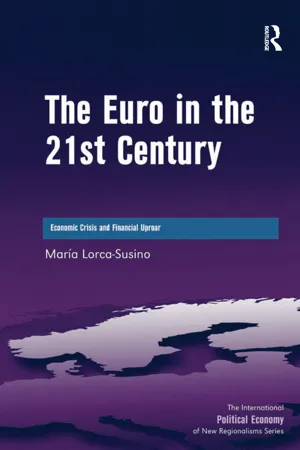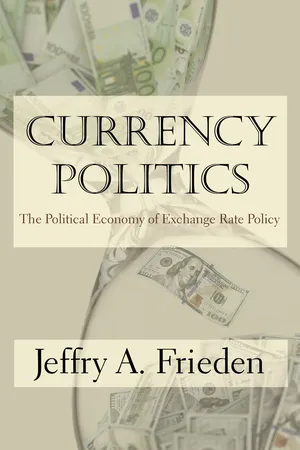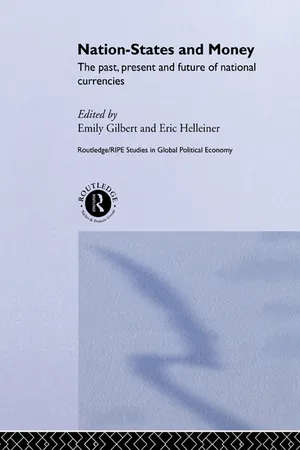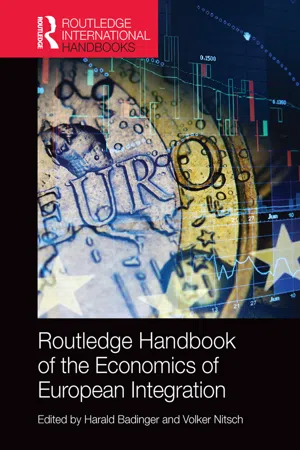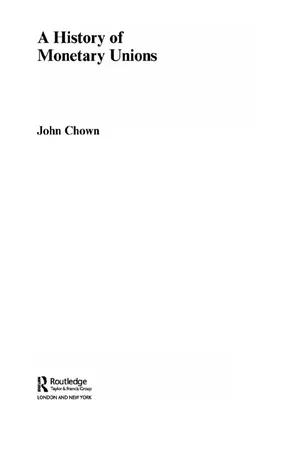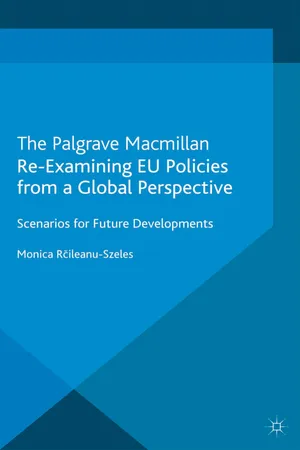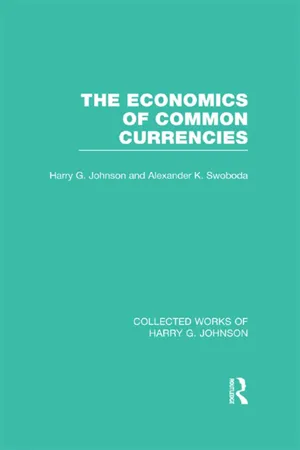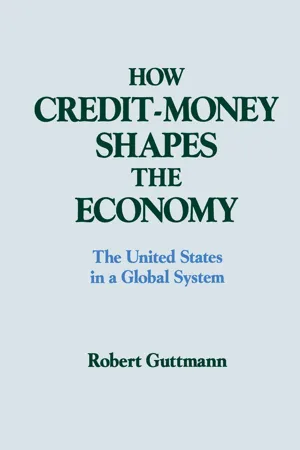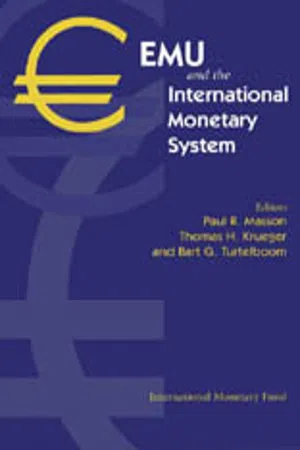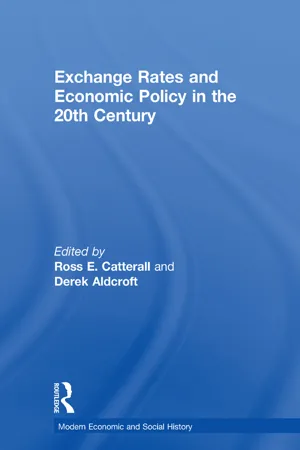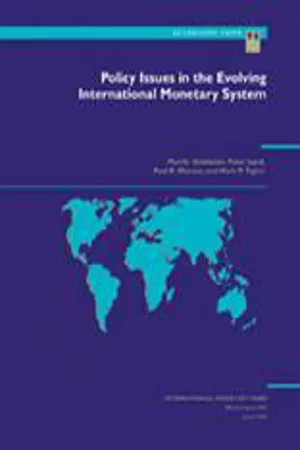Economics
European Currency
The European currency refers to the official currency used by the member countries of the Eurozone, which includes 19 of the 27 European Union (EU) member states. The currency is known as the euro (€) and is managed by the European Central Bank. It is one of the most widely used and traded currencies in the world.
Written by Perlego with AI-assistance
Related key terms
11 Key excerpts on "European Currency"
- eBook - ePub
The Euro in the 21st Century
Economic Crisis and Financial Uproar
- Maria Lorca-Susino(Author)
- 2016(Publication Date)
- Routledge(Publisher)
Chapter 2The Euro as a Common Currency
The adoption of the gold standard remained in effect until 1971when President Nixon eliminated the fixed gold price, and the Bretton Woods System disappeared. The demise of this system was followed by a period of monetary instability, which in the case of European countries led to the introduction of the euro as a common currency. The introduction of the euro has, therefore, been considered the most dramatic change in the monetary system since the adoption of the gold standard in the latter part of the nineteenth century.Before the euro was nominally introduced on January 1, 1999 and physically introduced on January 1, 2002, each country had its own currency representing the sovereignty of each nation and its people. When the time came to reach an agreement on a common European Currency many disputes ensued regarding what its format and essence would be. The original idea for a common European Currency came from the Nobel Prize winner, Robert Mundell, and his theory on Optimal Currency Areas. Back in 1970, Robert Mundell presented his work at the “Conference on Optimum Currency Areas” in Madrid. At this conference he presented a paper entitled “A Plan for a European Currency” (Mundell 1973a) in which he illustrated the gains that European countries would obtain by adopting a common currency, which he proposed to name the “Europa.”Following the conference, Lorenzo Bini-Smaghi, a senior staff member of the European Monetary Institute (EMI) asked Mundell if he had been the originator of the idea to name the currency “Europa.” Mundell explained that he thought that the popular usage would most likely end up being abbreviated as “euro” instead. In 1970 Bini-Smaghi invited Mundell to the European Monetary Commission and asked him how long it would take to create the European Currency, to which Mundell (2002b, 10) replied, “it is more difficult than you think. Even if there were no political impediments, it would take at least three weeks.” It took three decades. - eBook - ePub
Currency Politics
The Political Economy of Exchange Rate Policy
- Jeffry A. Frieden(Author)
- 2014(Publication Date)
- Princeton University Press(Publisher)
The eventual goal is for nearly all members of the European Union—save for those allowed to opt out—to adopt the common currency. This presents newer members of the European Union and those countries planning to join the European Union with the challenge of adopting appropriate currency policies. These countries, largely in central and eastern Europe, have in fact pursued a wide variety of different exchange rate policies. Some have been eager to join the euro, and several already have (Slovenia in 2007, Cyprus and Malta in 2008, Slovakia in 2009, Estonia in 2011, Latvia in 2014, and Lithuania in 2015). In preparation, a range of countries have adopted policies that link their currencies to the euro more or less rigidly. Other countries seem in no rush to join the eurozone or even fix their currencies to the euro. This is an interesting question, which I have addressed (with David Leblang and Neven Valev) with tools similar to those used here and with results very much in line with the assertion presented here. 39 Over the next decade, countries both inside and outside the eurozone will need to determine their policy toward adoption of or linkage to the euro. Eurozone member states have faced more immediate problems, however. The first few years of the euro were serene, but once the Great Recession began in 2007, conditions became much more difficult—and some observers even expected the eurozone to break up. Although a full analysis of the euro crisis, in all its various stages, is well beyond the scope of this book, it is worth describing the crisis and how its course reflects the factors of interest to this analysis. At the time of the euro’s introduction, it was clear to most observers that there were at least three key issues that had not yet been resolved. All three contributed to the crisis as it unfolded. The first problem that the EMU, like any currency union, faced was the underlying differences in macroeconomic conditions among the member states - eBook - ePub
- Emily Gilbert, Eric Helleiner, Emily Gilbert, Eric Helleiner(Authors)
- 1999(Publication Date)
- Routledge(Publisher)
This chapter examines why European national currencies, some of them internationally respectable ones, are seemingly ‘easily’ given up, in favour of a supranational currency. In order to understand what made this currency revolution possible the chapter looks at the specific circumstances under which the EMU project took off and the broader context in which this development has taken place. The structure of the chapter is as follows. The first section gives a brief history of currency co-operation in Europe. The second section discusses the various economic reasons for the creation of a European single currency. As that section argues, there are good economic reasons for adopting a single currency in Europe. However, in order to understand fully why a single currency, and not another scenario, was envisaged, political factors will be explored. This is done in the third section. The fourth section briefly looks into the reasons behind the political and popular opposition to the single currency. The final section draws some conclusions.Historical BackgroundIn order to understand the crossroads at which European nation-states stand it is important to have some sense of their history. This section discusses the general European integration process with particular emphasis on monetary cooperation and the circumstances under which EMU came on the European agenda.Currencies in European nation-states have had multiple functions over the past centuries (see the Introduction and chapters in the first part of this volume). During some periods they were considered less important political symbols than at other times. Sometimes multiple currencies circulated in any given country. Even monetary unions were created.2 It was not until the nineteenth century that European nation-states began to have fully developed national monetary systems, with a national currency being exclusive legal tender, and not until the early twentieth century that such national monetary systems became the norm across all of Europe.After the Second World War government involvement in the economy increased dramatically. A larger proportion of Gross Domestic Product (GDP) was redistributed or spent by the government. The role that national currencies played in each country’s national collective identity intensified at this point. State power over the economy made national monetary authorities keen on exerting control over the national currency and they limited or banned the use of foreign currencies. Yet, it was recognised that fixing exchange rates vis-à-vis - Harald Badinger, Volker Nitsch, Harald Badinger, Volker Nitsch(Authors)
- 2015(Publication Date)
- Routledge(Publisher)
2 The history of european economic and monetary union Harold James DOI: 10.4324/9781315796918-3 1 Introduction Europe’s move to monetary integration with a common currency (the euro) is a quite unique process, and is often held up as a model for monetary cooperation in other parts of the world: in the Gulf region, where there are periodic discussions of monetary unification, as well as in Asia and Latin America, where movements towards greater monetary integration also have some support but encounter a plethora of difficulties. Nevertheless, at the latest by the financial crisis of 2007–8, it became clear that there were substantial design flaws in the concept of the Economic and Monetary Union (EMU). As Patrick Honohan put it: “release 1.0 of the euro was under-designed, and robust only to moderate shocks.” (Honohan 2012) There has always been an ambiguity in the story of monetary integration: was it designed primarily to deal with a technical issue – alternatively formulated as exchange rate volatility as a barrier to trade and thus to greater economic integration, or else as a quest for price stability – or was it part of a grand political plan, in which money was used to tie the European knot? Jacques Rueff (1950), France’s major mid-century thinker about money, coined a phrase that was subsequently often erroneously linked to Jean Monnet: “L’Europe se fera par la monnaie ou ne se fera pas.” In the 1960s, a theory of optimum currency areas was developed by US-based economists (Mundell 1961, McKinnon 1963, Kenen 1969): although they continued to be influential figures in the European debate, their theories were irrelevant to the final push to monetary integration in the 1990s. The states that signed up to economic union had different expectations and hopes: some saw it as a way of building credibility and thus of reducing borrowing costs, while others focused on the constitutionalization of a stable monetary regime- eBook - ePub
- John F Chown(Author)
- 2003(Publication Date)
- Routledge(Publisher)
The Maastricht treaty (Article 1091(4)) provided that the conversion rates of the currency should be ‘irrevocably fixed’ and that the euro would have the same value as the Ecu at 1 January 1999. This seemed a good idea at the time, as it was assumed that the rates would only be set at the end of 1998. In the event, it was decided to fix the rates between the eleven participating currencies in May 1998, months earlier than the formal introduction of the euro. This created a problem, as the Ecu was still defined as a basket of twelve currencies, three of which, the United Kingdom, Denmark and (it was then assumed) Greece, would not be joining EMU. Currencies in the euro zone constitute only 83.5 per cent of the Ecu basket, and until the end of 1998 the euro was literally indefinable (although its value could be estimated accurately enough from forward rates), and for the rest of the year foreign exchange transactions had to be one of the eleven legacy currencies. But for the wholly artificial attempt to create this one-to-one link, the euro could have been given an immediate valuation in May.Subject to this transitional problem, there was an effective monetary union with fixed rates between the participating countries, but it was to be another three and a half years before travellers would have the benefit of a common currency, and during this period little progress was made with reducing bank charges for cross-border payments. At the beginning of 2002, euro notes and coins (which few people had actually seen in advance) were brought into circulation to a general (but not universal) welcome. A complex administrative task (for which, after all, there had been plenty of time to prepare) appears to have gone well with few problems, apart from some banking strikes. From an economist’s point of view, though, the interesting stage of the experiment was just beginning.Passage contains an image
39 European Monetary Union
Policy issues
Introduction
Much has been written for and against monetary union, and whether or not a particular country should join. The literature is of varying quality, and this is not the place to add to, or even survey it, particularly as the main issues have been discussed in a historical context. This chapter simply gives a highly selective account of what seem to the author to be particularly significant, and perhaps less obvious, contributions. - eBook - ePub
Re-Examining EU Policies from a Global Perspective
Scenarios for Future Developments
- Kenneth A. Loparo, Kenneth A. Loparo(Authors)
- 2013(Publication Date)
- Palgrave Macmillan(Publisher)
1 The European Monetary Policy and Euro Drift in the Aftermath of the Economic Crisis Monica Ră ileanu SzelesMonetary unification – a step towards in-depth European integrationA historical perspective on the European Monetary UnionThe adoption of the euro as their common currency by 11 member countries of the European Union (EU) in 1999 represented a major step in the European integration process. It was aimed at consolidating internal economic unity and giving the EU a stronger position in international affairs.The story of the European monetary policy begins with Pierre Werner, who was prime minister of Luxembourg from 1959 to 1974 and again from 1979 to 1984. He is considered to be the “father of the euro”, given that during his political career he conducted a large-scale campaign for a single European Currency and European monetary policy. The idea of a single European Currency was first officially presented at a summit in The Hague (December 1969). According to Werner’s plan, the introduction of a single European Currency was not a goal in itself. The final phase of his plan concerned the achievement of total convertibility of member states’ currencies, the full liberalization of capital movement and the irrevocable fixing of exchange rates.Despite the initial enthusiastic debates about the prospects for launching a European single currency, the European Monetary Union (EMU) project entered a short period of high instability in 1971, when the Bretton Woods system ended. After introducing the system known as the “snake in the tunnel” (a managed floating of currencies around the dollar) in 1972, most of the member states abandoned the monetary arrangement, and only Germany, Denmark and the Benelux countries continued to use the system. - eBook - ePub
The Economics of Common Currencies
Proceedings of the Madrid Conference on Optimum Currency Areas
- Harry Johnson, Alexander Swoboda(Authors)
- 2013(Publication Date)
- Routledge(Publisher)
The dollar becomes the medium of exchange of commodities. As long as the dollar is the world currency, which it is increasingly becoming, America will maintain the commercial and financial advantages, intrinsic in its vastness. But currency rights are man-made and reversible, the prerogative of the sovereign state. We have seen that hope for the national currencies of Europe is slim in the very long run. But there is possible in the field of money a development ruled out in the field of language, namely, a European money – if there is a political will and if it is felt that European independence is worth preserving. For a European money can be created in a year, and the balance of advantages, now weighed overwhelmingly on the side of the United States, redressed.Money is the key that can unlock the doors that are currently barriers to the flow of information and finance. Instead of gratuitously ceding to the United States the enormous advantages in the fields of both language and money, it can take the first fundamental steps through the creation of a money.American technology, capital and power are transported through the media of the American language and the American money. Europe needed something like the dollar in the initial post-war period, but now the need is over. Now she needs a monetary union. A monetary union has become possible because Europe has become a security area, a war-free domain.One must be careful to distinguish between two different approaches to the question of European integration. One is to ask: What is the appropriate degree and kind of integration taking Europe alone into account? The other involves the extra-European context.If we take Europe alone into account we can accept the need for some degree of integration to capture the spillover effects in the fields of transport, communication, entertainment, education, technology and defence. Informal methods of co-operation, combined with a few rules and treaties, might suffice and a tight degree of integration rendered unnecessary. All the gains and pleasures associated with the university of natural cultures could be preserved. - eBook - ePub
How Credit-money Shapes the Economy: The United States in a Global System
The United States in a Global System
- Robert Guttmann(Author)
- 2016(Publication Date)
- Routledge(Publisher)
• The Delors Plan then envisaged establishing a framework to set key economic objectives and budget deficit limits. The community would monitor the performance of individual members. If a nation were to run too large a budget deficit, it could be ordered to trim that deficit. During this second stage a European System of Central Banks, similar in structure to the U.S. Federal Reserve, would be introduced. Individual central banks would turn into regional branches of the new EuroFed, thus forming the institutional basis for an EC-wide common monetary policy.• In the final stage, exchange rates would become irrevocably locked. Members would agree to make the rules for macroeconomic and budgetary policy binding. The EuroFed would assume full responsibility for making the community's monetary policy, intervening in the currency markets, and holding reserves. The process would conclude with the adoption of a single currency for the entire region.Delors presented his single-currency plan as a central element in the move toward a barrier-free Europe. Once there were a single European capital market in 1992, the current status quo would become untenable. Only with such monetary union, he argued, could there be true economic integration. Adoption of his plan would promote faster growth, would encourage greater efficiency, and would give Europe more clout vis-a-vis the United States and Japan.These arguments found broad support in the private sector. Surveys clearly indicated that a majority of corporate managers in Europe favored the ECU becoming the main currency for commerce within the EC. This attitude came as no surprise. A single currency promised to yield significant cost savings. Companies could avoid the transaction costs of foreign exchange as well as the costs of hedging against currency fluctuations. They would also have clearer information about prices and costs throughout the EC if those were measured by the same standard of value. Bankers expressed similarly positive sentiments with regard to the Delors Plan, realizing that a single-currency system would greatly facilitate the integration of financial institutions and markets within the EC.21 - eBook - ePub
- INTERNATIONAL MONETARY FUND(Author)
- 1997(Publication Date)
- INTERNATIONAL MONETARY FUND(Publisher)
The more interesting issue is not whether EMU will tend to promote greater exchange rate stability either de facto or de jure but whether it is likely to suggest that a widespread movement toward a world currency or several regional currencies would be desirable. If EMU is a success in the sense that as many as 15 countries are judged to be able to enjoy a higher level of prosperity with a single currency and a supranational central bank, why shouldn’t a larger portion of the world adopt such arrangements? From this perspective, European monetary integration might ultimately make a positive contribution to the international monetary system, but I suspect that most of us would agree that any payoff is likely to be a long way down the road.The third question is what are the implications of European monetary integration for the functioning of the international monetary system? In my view, this is a more serious and immediate question than that of the implications of European monetary integration for the structure of the exchange rate regime. What are the practical implications for the smooth functioning of the international monetary system of a situation in which major countries participate without currencies of their own and the system includes an essentially stateless currency? Quite frankly, I do not think we know. We do know that there is some unfinished business in terms of short-run arrangements in Europe and some large questions in terms of longer-run evolution of Europe.Ever since the establishment of the EMS, one preoccupation of some economists and officials has been whether economic policy in the context of increased European monetary integration will tend to have a deflationary bias. That is an important question for Europe as well as for the rest of the world, but the more important question for the rest of the world is whether the process of cyclical adjustment within Europe generally will have benign or adverse implications for the global economy. After January 1, 1999, Europe will have a supranational monetary authority. Its relationship with both the Brussels process and national governments will be complex; it will be governed by a combination of legal obligations and arrangements, but it will be shaped and tested by experience. The concern is that because Europe will be living in a halfway house where economic decision making is shared in an uncertain manner, the smooth functioning of the international monetary system could be adversely affected. - Derek H. Aldcroft, Ross E. Catterall(Authors)
- 2017(Publication Date)
- Routledge(Publisher)
CHAPTER FOUR European monetary union: does recent economic history in the UK suggest that exchange rates pose significant trade barriers? Allan WebsterIntroduction
This chapter is concerned with using the evidence of recent economic history in the UK to establish whether membership of the European monetary union would be likely to produce significant benefits. The focus of the chapter is microeconomic. That is, it starts from a position that the literature concerning the potential macroeconomic benefits suggests that membership of the monetary union would yield at least highly debatable benefits and, more likely, would involve economic costs. The literature concerning microeconomic benefits, which arise from the removal of barriers to trade created by exchange rates, provides a less ambiguous case for supposing that potential gains exist from membership of the monetary union. The critical question, therefore, is whether these microeconomic benefits are likely to be sufficient to offset macroeconomic costs (if there are any) or, at least, to nullify doubts arising from the risk that macroeconomic costs might arise.The object of this chapter is to use evidence from the recent history of the UK to establish how important the microeconomic costs of exchange rates have been. This provides a basis for making a broad assessment of the likely gains to be secured from abolishing exchange rates between the UK and the relevant European countries.The approach of the chapter is in five stages. In the next section a brief review of the main macroeconomic issues is provided. This is intended neither to be a comprehensive treatment of the macroeconomics of monetary union nor even necessarily to provide a balanced treatment of the issues. It serves only to demonstrate that it is possible to make a case that the microeconomic issues are of particular importance. In the third section a brief summary of the literature concerning the nature of the microeconomic costs – transactions costs and risk – of exchange rates is provided with a summary of available quantitative evidence on their magnitude.- Mark Taylor, Peter Isard, Morris Goldstein, and Paul Masson(Authors)
- 1992(Publication Date)
- INTERNATIONAL MONETARY FUND(Publisher)
T his paper has focused on the value of exchange rate unions for particular groups of countries and on those characteristics that are likely to make a monetary union desirable and viable. The present situation facing industrial countries is one of high, and increasing, international financial integration; in those circumstances, some loss of monetary independence is inevitable. The fundamental question implied by membership in a currency union is whether the loss of monetary independence is likely to be more than compensated for by reductions in transactions costs and in exchange rate uncertainty, by superior inflation performance, and by the credibility added to the global purpose of economic and policy union. This question is currently most relevant to the EC, where moves toward currency union are part of a general trend toward greater economic and political integration. However, it is also relevant for other potential and existing currency unions, as well as for the entire membership of the IMF, as regional currency unions are likely to affect the functioning of the international monetary system.Passage contains an image
References
1Aizenman Joshua, and Jacob A. Frenkel “Optimal Wage Indexation, Foreign Exchange Intervention, and Monetary Policy ,” American Economic Review , Vol. 75 (June 1985), pp. 402–23.2Alexander William E., and Dale W. Henderson “Liberalization of Financial Markets and the Volatility of Exchange Rates ,” in Trade and Investment Relations Among the United States, Canada, and Japan ,ed. by Robert M. Stern (Chicago: University of Chicago Press, 1989), pp. 365–78.3Allen Polly Reynolds, Organization and Administration of a Monetary Union , Princeton Studies in International Finance, No. 38 (Princeton, New Jersey: International Finance Section, Department of Economics, Princeton University, 1976).4Argy Victor, “Choice of Exchange Rate Regime for a Smaller Economy: A Survey of Some Key Issues ,” in Choosing an Exchange Rate Regime: The Challenge for Smaller Industrial Countries ,ed. by Victor Argy and Paul De Grauwe (Washington: International Monetary Fund, 1990), pp. 6–81.5Argy Victor, and Paul De Grauwe “Introduction ,” in Choosing an Exchange Rate Regime: The Challenge for Smaller Industrial Countries
Index pages curate the most relevant extracts from our library of academic textbooks. They’ve been created using an in-house natural language model (NLM), each adding context and meaning to key research topics.
